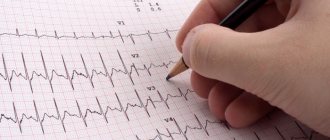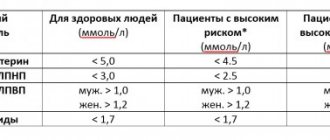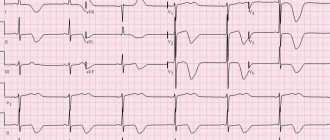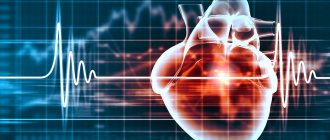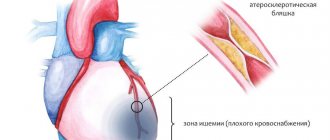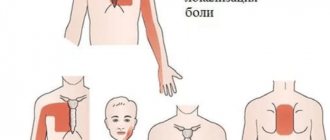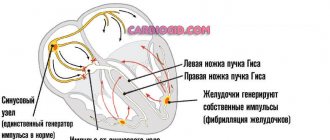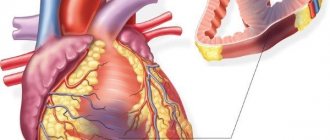Damage to the muscular layer of the heart wall of various etiologies is ischemic disease. The root cause is a significant deterioration in the blood supply to the myocardium, and in some cases its complete absence.
In the female population, the disease often occurs in a latent form, when complications have already formed. The explanation is the fact that the female body produces the hormone estrogen, which protects vascular structures from atherosclerotic lesions for a long time. The risk of developing IHD (coronary heart disease) in women is quite high, since the influence of many negative factors is great.
Causes and predisposing factors
Coronary heart disease is diagnosed in the female half of humanity after they reach the age of 50–55 years. Over the past decades, experts have noted a steady increase in incidence, which is explained by various reasons: from physical inactivity to an uncorrected diet.
The list of causes and predisposing factors includes:
- individual habits, especially abuse of alcohol and tobacco products;
- existing abnormalities in metabolic processes, for example, nutritional obesity, diabetes;
- hormonal imbalance: menopause;
- uncorrected diet: predominance of heavy, fatty, fried foods, as well as sauces, pastries and sweets in the menu;
- exposure to physical inactivity: work activity often takes place while sitting at a desk;
- fluctuations in pressure parameters: hypertension;
- unfavorable hereditary predisposition, if one of the blood relatives already has myocardial ischemia, then the risk increases by 25–30%, if two or three relatives have it, then the chances of “earning” the disease increase to 45–50%.
Frequent severe stressful situations also contribute to the formation of blood flow disorders in the muscle layer of the heart.
Treatment of coronary artery disease
Treatment of IHD is carried out comprehensively in the following areas:
- prevention of myocardial infarction, prevention of death;
- relief of pain;
- restoration of damaged vessels.
Treatment is prescribed using pharmacological therapy aimed at combating atherosclerosis and thrombosis. An important role is played by adjusting lifestyle, giving up bad habits, and following the principles of proper nutrition. The general complex of treatment for coronary heart disease is based on research results and is prescribed by a specialist.
Features of the course of the disease
Foci of ischemia in the muscular structures of the cardiac organ are common causes of death among women. Especially among people living in highly developed industrial cities. It is worth noting that the pathology is practically not diagnosed before the age of 50–55, but after the onset of menopause: against the background of a significant decrease in estrogen production, the incidence rates are similar to those for men and in some cases even exceed them.
Distinctive signs of coronary heart disease in women:
- the debut of a pathological condition such as myocardial infarction; mortality reaches high figures;
- risk factors have a detrimental effect on the condition of the myocardium and in a shorter period of time than in men;
- angina attacks without a typical pain syndrome are characteristic: insufficiency of blood flow in the myocardium is practically asymptomatic, which causes a small percentage of pathology detection at the initial stage of its appearance;
- Women more often have a variant of exertional angina, rather than a stable type of the disease: pain impulses arise suddenly during a night's rest, continue for a long time, and are difficult to treat pharmacotherapy, even with medications from the nitroglycerin subgroup;
- Female representatives, of course, more often seek medical help, but at the same time they have a tendency to neuroticism and depressive states, which can complicate an adequate differential diagnosis.
The typical clinical picture of an ischemic attack does not raise doubts among specialists. However, the course of the pathology can be so variable that the help of highly qualified cardiologists is required.
Classification by type of disease
The disease is divided into types according to reversibility and severity. Chronic ones can last for several years, while acute ones can last for a couple of hours or even minutes.
- Sudden coronary death. This type of ischemia after its onset within a few hours leads to death. Refers to acute.
- Angina pectoris is the most “popular” type. Its peculiarity is that the pain is stabbing in nature and manifests itself in one place. Typically, the chest area is affected first, accompanied by difficulty breathing. The lesion then moves to the left arm or shoulder blade. Less often - in the stomach, which can complicate diagnosis. A subtype of angina is tense. It is the result of physical activity. It is also divided into: Stable, arising as a result of a specific load - running or climbing stairs.
- Unstable - the result of myocardial infarction.
Who is at risk
The main emphasis is on correcting the woman’s diet; the diet should be dominated by dishes from plant products, vegetables, and seafood.
The concentration of fats in them is minimal, and the volume of microelements useful for the myocardium, for example, potassium and magnesium, as well as vitamins, is quite high.
Acute insufficiency of blood flow in the heart area can happen to almost every person, but experts identify a special subgroup of people who have a high risk of this disease:
- with high cholesterol levels in the bloodstream: atherosclerotic plaques literally block the lumen of the coronary vessels, thereby creating a significant obstacle to the delivery of nutrients and oxygen to the myocardium;
- with frequent increases in blood pressure, which provokes disturbances in the vascular wall; moreover, during a hypertensive crisis, the lumen of the vessels is very small, which means that access of blood flow to myocardiocytes is difficult;
- with existing diabetes: hyperglycemia has a detrimental effect on all organs of a woman, but primarily on the coronary structures;
- with a negative hereditary predisposition: if blood relatives suffered a myocardial infarction or died from severe cardiovascular failure, the risk of transmitting the disease increases several times.
In addition to the above criteria for selecting people who have every chance of “getting” coronary heart disease, you must also pay attention to the following:
- the lack of any physical activity - physical inactivity - is becoming a real disaster for people, especially in large populated areas; women are increasingly working in areas where they have to remain in a sitting position throughout the working day;
- nutritional obesity: with every extra kilogram, the risk of the formation of an ischemic focus in the myocardium increases many times;
- excessive passion for alcoholic products: such “small” weaknesses contribute to disruption of metabolic processes, which, in turn, provokes atherosclerosis, and then coronary insufficiency;
- Other criteria include taking oral contraceptives, varicose veins, chronic stress and age after 65–70 years.
Identification of even one of the above sub-points is a reason to immediately contact a specialist and undergo a comprehensive diagnostic examination.
Signs and symptoms of coronary heart disease in men and women
Coronary heart disease is a dangerous disease that affects the heart structures, leading to loss of its performance. It often ends in death. Currently, this pathology occurs in many patients at a fairly young age. In this article we will talk about this disease and how it develops depending on gender. We will also consider its clinical manifestations, taking into account the form and stage of development.
There are several factors that provoke the development of IHD:
Risk factors
The formation of coronary heart disease is influenced by a number of factors:
How is CHD diagnosed and what indicators do specialists use, read on.
The following reasons are identified that cause the development of coronary heart disease in men:
Features of the development of the disease
Ischemia is always caused by impaired blood supply to the heart muscle. The disease develops in two ways.
In the first case, ischemia becomes a “heat” disease. Its appearance is associated with increased production of cholesterol in the liver. With this path of development of the disease, you will need to take care of switching to proper nutrition and giving up any bad habits.
The second path of development is “cold”. In this case, the gastrointestinal tract does not function properly and lipid metabolism is disrupted.
IHD in men develops under the influence of various factors:
- Atherosclerosis of the coronary arteries. Chronic disease leads to hardening of the heart muscle and loss of elasticity of the arterial walls. Sooner or later, a disruption of the blood supply to the heart occurs.
- Spasm of coronary vessels. It often accompanies atherosclerosis, under the influence of which the coronary arteries cease to sufficiently nourish the heart.
- Thrombosis of the coronary arteries. Such a dangerous disease is usually caused by the rupture of an atherosclerotic plaque that enters the artery. This condition is one of the most dangerous.
In many situations, problems such as high cholesterol, smoking, excess weight, high blood pressure, diabetes, lack of physical activity, and constant stress lead to coronary heart disease.
Doctors recommend regular examinations by cardiologists, and the importance of diagnosis increases after 40 years.
In many situations, problems such as high cholesterol, smoking, excess weight, high blood pressure, diabetes, lack of physical activity, and constant stress lead to coronary heart disease.
Development of ischemic heart disease in men
With ischemia, the symptoms are irreversible, and as a result, it is completely impossible to cure the disease. Modern medicine makes it possible, in one way or another, to stop the development of coronary artery disease and, as far as possible, to keep its course under control.
Although patients in most cases are seen by doctors and receive the necessary treatment, heart disease affects the functioning of other organs. In medicine, this is called the “cardiovascular continuum” (CVC).
Diseases that include SSC:
- ischemia;
- hypertension;
- atherosclerosis;
- stroke;
- arrhythmia.
This list also includes other diseases that affect the functioning of the kidneys, brain and pancreas.
SSC has 4 stages of development:
- Asymptomatic stage. During the accumulation of cholesterol in the vessels, their lumen gradually narrows, but not so much that the first symptoms appear.
- First signs. At this stage, men are overtaken by hypertension, increased sugar and cholesterol levels. The lumen of the arteries is reduced to half, and the heart muscles are subject to deformation.
- Development of symptoms. Shortness of breath appears, the heart rhythm is disturbed, and painful sensations appear in the chest area. The lumen of the vessels becomes narrower, and an ultrasound examination shows an increase in the cavities of the heart.
- Final stage. Numerous edema appears, congestion occurs in the lungs, and heart failure develops. Symptoms are accompanied by sudden surges in pressure and chest pain even in a calm state.
In the first case, IHD begins to develop at a faster pace.
- Assessment of pain syndrome.
- Prescribing an ECG, which will help identify the presence of tissue death or ischemia.
- Prescribing blood tests to assess the amount of enzymes in its composition.
Chronic forms of IHD
Cardiosclerosis is an irreversible pathology; maintenance therapy does not eliminate arrhythmia and manifestations of CHF, but only alleviates the patient’s condition.
When you can’t do without the help of a cardiologist
Numerous medical studies convincingly prove that timely contact with a cardiologist at the slightest deviation in health helps to improve the prognosis of survival and work ability in women.
It is recommended to seek advice from a specialist if there is the slightest deviation in your health. For example, even a slight increase in the usual load leads to shortness of breath, even worse if it is observed at rest. From time to time I experience discomfort of a stabbing, aching nature in the left half of the chest or the area of the heart. The pain may initially go away on its own, then to eliminate it requires taking mild sedatives and analgesics. Sometimes you have to call an ambulance because you suffer from intense pain in the chest.
Persistent rapid heartbeat should also be alarming: recording more than 100 heart beats per minute, more than three to five events in the last month. Especially in combination with surges in blood pressure above 140/85 mmHg.
Such manifestations begin to worry women after a significant decrease in their production of the sex hormone estrogen, which previously protected the structure of the cardiovascular system with its influence. You should not expect that negative symptoms will go away on their own; it is better to prevent the occurrence of pathology and take preventive measures.
Possible complications and consequences for men
As is known, ischemia develops against the background of impaired blood supply to the heart muscle, so the main complications are forms of the disease - angina, heart attack, etc., which can lead to sudden cardiac arrest. When the pathology worsens, cardiogenic shock occurs, which is characterized by a sharp decrease in blood pressure, unconsciousness and superficial pulse.
A common complication is liver and kidney failure, disruption of the central nervous system, and swelling of the lungs. With each form of the disease, different consequences develop; for example, after a heart attack, a person may remain disabled. Quite often, men's potency weakens and infertility develops.
Diagnostics
If there is a suspicion of the presence of foci of ischemia in the myocardium in the female body, the specialist takes a number of measures to confirm or refute the preliminary diagnosis. All symptoms of coronary heart disease are carefully checked.
The anamnesis is collected especially carefully:
- personal: when the woman noticed the first disruptions in her health, what was the intensity of the pain impulses, what provoked their appearance, what measures helped eliminate them;
- professional: who does the woman work, what are the conditions at her workplace, are there conditions for a lunch break, the opportunity to warm up;
- family: whether there are blood relatives who have suffered or currently have pathologies of the structures of the cardiovascular system, what diseases have been passed on to the woman in the family.
Among laboratory studies, special attention is paid to the parameters of biochemical analysis: the concentration of cholesterol and its fractions, triglycerides, as well as glucose and transaminase.
Experts include examinations by means of:
- ECG;
- bicycle ergometry;
- echocardiography;
- Holter monitoring (HM).
However, coronary angiography is the most informative; it allows you to narrow the area of study, establish the exact localization of atherosclerotic defects, and the degree of disturbance of blood flow through the coronary vessels. At the time of the diagnostic procedure, a specialist may identify other abnormalities: the presence of a blood clot or a wall tear, hyperspasm.
Is ischemia in women a myth?
Coronary heart disease refers to damage to the muscular layer of the heart wall – the myocardium. The main reason for this phenomenon is insufficient, and in the worst case, complete cessation of blood supply to muscle tissue. The disease can occur in an acute form, then myocardial infarction is diagnosed.
In the chronic course of the pathological process, a diagnosis of angina pectoris or chronic heart failure is made. It should be noted that while the factors that caused these diseases are similar, they differ in their characteristic clinical manifestations and treatment methods. However, all patients with cardiac ischemia should be observed by a cardiologist and promptly receive etiotropic treatment.
Why has coronary heart disease been diagnosed predominantly in men for a long time, and only recently has this diagnosis begun to be given to women? The cause of the development of this pathology is atherosclerotic changes in the vascular walls. This means that the patient must initially be diagnosed with atherosclerosis.
But atherosclerosis in women is quite rare, and it develops in old age. What is the reason? The female body produces the hormone estrogen, which protects blood vessels from atherosclerotic changes. However, the risk of developing IHD in this population is still quite high, which is due to a large number of possible risk factors, as well as unclear symptoms of the pathology.
What help to provide before the ambulance arrives?
From the first seconds of a sharp deterioration in well-being: severe pain impulses in the left half of the sternum with their irradiation to the scapula or shoulder, the woman requires emergency assistance. Otherwise, there is a high risk of death of myocardiocytes with subsequent severe pathology, including death.
At the first symptoms of coronary heart disease, it is recommended to take the following actions:
- If possible, quickly eliminate the factor that led to the creation of a negative situation;
- immediately contact medical workers: call emergency medical services;
- ensure maximum influx of air masses in order to facilitate breathing;
- give medications that previously bring a woman relief, for example: “Corvalol”, “Validol”, “Valerian”;
- in the absence of a pronounced effect, a painful attack persists for more than 5–7 minutes, it is recommended to give the patient “Nitroglycerin” or its analogue; three doses of such drugs are allowed.
The remaining measures will be carried out by the ambulance team that has already arrived after deciphering the ECG and emergency differential diagnosis. Taking any unfamiliar medications that have not been previously prescribed by your doctor is absolutely unacceptable. Such actions can significantly aggravate the situation.
Treatment of coronary artery disease
Treatment of IHD is carried out comprehensively in the following areas:
- prevention of myocardial infarction, prevention of death;
- relief of pain;
- restoration of damaged vessels.
Treatment is prescribed using pharmacological therapy aimed at combating atherosclerosis and thrombosis. An important role is played by adjusting lifestyle, giving up bad habits, and following the principles of proper nutrition. The general complex of treatment for coronary heart disease is based on research results and is prescribed by a specialist.
Treatment tactics
At the initial stage of the formation of ischemic failure in myocardial tissue, therapeutic measures are reduced to correction of the woman’s lifestyle, diet and physical activity. If you follow all the recommendations prescribed by the cardiologist, you can achieve pronounced positive dynamics and a significant improvement in your well-being.
Since the main risk factors include excessive consumption of tobacco and alcohol products, they will have to be abandoned. Then the diet is carefully reviewed: heavy, fatty, fried foods, various sauces and smoked foods, as well as canned food, coffee, and other strong drinks are completely excluded from the menu. In most cases, they become the root cause of the formation of atherosclerotic defects in the bloodstream.
At the next stage, the specialist will individually select the optimal combination of medications. Their main goal is to reduce the oxygen demand of myocardiocytes, stabilize the supply of nutrients to the myocardium, and also prevent the frequent occurrence of angina attacks. Main subgroups of medications:
- beta blockers;
- nitrates;
- antiplatelet agents;
- statins;
- diuretics;
- cardioprotectors.
If necessary, other medications may be included in complex treatment. The frequency of administration and the total duration of the treatment course are determined by the cardiologist based on the diagnosed stage of the pathology, the severity of negative symptoms, as well as the woman’s age category, her initial health status and drug tolerance.
Possible complications
A woman’s physical activity is also subject to review: dosed loads are necessary. They will help strengthen the myocardium and coronary vessels in general.
The most commonly diagnosed complications and consequences of emerging ischemic disease today include:
- Local focus of acute necrosis, death of myocardiocytes. Myocardial infarction has become significantly younger over the past decades. Provoking factors are atherosclerotic plaques or blood clots that enter the heart from other parts of the body.
- Various blockades or arrhythmias. Nature provides an optimal mode of contractions of all structures of the heart, ensuring a complete supply of blood saturated with oxygen and nutrients; a failure in this well-functioning system immediately affects the organ itself, which only worsens the woman’s well-being.
- Impaired ability of the heart to move blood flow through the systemic and pulmonary circulation is called heart failure by specialists; its result is the appearance of edema, shortness of breath, and a state of hypoxia in all tissues and organs.
To avoid all of the above, it is enough to regularly undergo preventive medical examinations and seek additional consultations when you identify the first signs of disorders in the cardiovascular system.
Signs of angina
The most common form of coronary artery disease in men is angina pectoris. It can be stressful (occurs after physical stress) or spontaneous. There are also stable and unstable angina. Stable angina occurs predominantly in men over 45 years of age. It is caused by atherosclerosis and arterial thrombosis.
This form of coronary artery disease in men is manifested by pain. The latter has the following characteristics:
- is burning, pressing or squeezing;
- felt behind the sternum on the left;
- radiates to the shoulder blade, collarbone, arm or neck on the left side;
- does not change during inhalation and exhalation;
- appears during physical activity;
- lasts up to 15 minutes;
- constant in strength and long-lasting (stable);
- disappears with rest and after consuming nitrates;
- often accompanied by a feeling of fear;
- does not depend on food intake;
- combined with lack of air and sweating.
The peculiarity of the pain syndrome is that it is constant in time and intensity. If with each attack the pain lengthens, becomes stronger, and the effect of Nitroglycerin decreases, this indicates the development of unstable angina in a man. This form of coronary heart disease is more severe and more often leads to complications (heart attack). With unstable angina, there is no clear dependence of pain on physical activity.
Often the attack develops at rest. The pain can be local and felt only in one area without irradiation. Often it is encircling. Pain occurs more often than with stable angina. It is longer and more acute, but lasts less than 15 minutes. Often sick men need to take several tablets of Nitroglycerin to eliminate it, as the effect of the medicine is reduced.
Prevention
Various manifestations of coronary disease originate, as already mentioned, in disruptions in the blood supply to the myocardium. Therefore, all preventive measures recommended by cardiologists or other specialists boil down to preventing the very possibility of such a failure occurring.
The woman’s habits are also reviewed: it is recommended to get rid of smoking, drinking alcohol or other intoxicants. It is necessary to ensure a good night's rest in a well-ventilated area, on a comfortable bed.
It is advisable for a woman to make it a rule to take a walk after work: to walk several blocks a day at a leisurely pace. And on weekends, visit forest parks and outdoor recreation areas. Optimal physical activity is also considered visiting a swimming pool or fitness room. These simple rules make it possible to prolong the youth of the “motor” in the human body and avoid the occurrence of ischemia in the myocardium.
